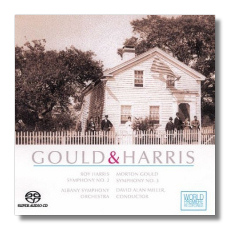
The Internet's Premier Classical Music Source
Related Links
-
Harris Reviews
M. Gould Reviews - Latest Reviews
- More Reviews
-
By Composer
-
Collections
DVD & Blu-ray
Books
Concert Reviews
Articles/Interviews
Software
Audio
Search Amazon
Recommended Links
Site News
 SACD Review
SACD Review
American Symphonies

- Roy Harris: Symphony #2
- Morton Gould: Symphony #3
Albany Symphony Orchestra/David Alan Miller
Albany Records TROY515 Hybrid Multichannel SACD 62:07
RECOMMENDATION: an exceptionally apt pairing of two long-neglected but exciting symphonies that deserve to be much better known. Performances and recording are excellent.
Morton Gould is not generally known primarily as a composer of symphonic music. In fact, much of his career was involved with arrangements of popular music for orchestra and he is probably more often thought of in terms of that. However, much of his music was regarded with respect by quite a number of the major symphonic conductors of his day, including Reiner, Stokowski, Szell, Toscanini, Mitropoulos, and Barbirolli, as well as soloists such as Heifetz. Undoubtedly, had Gould not accepted the financial burden of supporting his parents and siblings at an astoundingly young age, instead of accepting the full scholarship to Curtis to study with Fritz Reiner that he was offered, his career would have taken a very different course. As things fell out, Gould became very successful in the early years of radio broadcasting, and critical reaction to his most serious compositions was surely influenced by the reputation he established there. I can strongly recommend the very well-written biography of Morton Gould by Peter W. Goodman for the specifics.
I can also strongly recommend this well-prepared, well-performed and well-recorded CD of Gould's splendid Symphony #3 – as well as its very apt disc-companion, Roy Harris' Symphony #2. Both works have been in near-oblivion for many years and Albany is to be commended for this extremely welcome release.
The Gould Third, written in 1947, runs well over forty minutes. It inhabits the same sound-world as other mid-20th century neoclassical American symphonies, including Harris', but as Goodman says, "there isn't a trace of folkloric Americanism" in it. The work is performed here with its original fourth movement, rather than with the passacaglia and fugue that he was persuaded to substitute after its première. It opens strongly, perhaps with "vehement anguish", as Roy Bono, the Albany commentator, hears it, but perhaps also with something quizzical in its expression. Both of these expressive elements pervade the movement, and there is much loud brass and pounding percussion, but this tension eases more than once and there is some flowing melody and quiet woodwind.
The long second movement marked simply "moderately slow and relaxed" is quietly songful, with pleasurable melodies, and its mood is in marked contrast to what precedes and follows.
A scherzo follows. Marked "moderately fast with sardonic humor," it has been called a jazzy fugue. It is perky, then brash, even uproarious. Some material included along the way suggests that Gould might be thumbing his nose at those critics who looked down on his taste for the popular and who questioned whether his music was truly classical. I just love it.
The finale is varied in musical and expressive effect, and is brilliantly scored. (Nobody ever questioned Gould's mastery of orchestration.) From a tentative opening, broad phrases yield to spritely melody before momentum picks up and fast pounding rhythm imposes itself (in a passage perhaps reminiscent of Shostakovich). There are some hushed moments before a soaring trumpet demands one's attention before the end.
Roy Harris' Second Symphony, written for the Boston Symphony in 1934, is half the length of Gould's Third, though if you consider that Harris' great Third Symphony runs only 17 minutes, this proves nothing. But the première, not even attended by the composer, did not go well and Harris withdrew the work. Many revisions had preceded these events. For the present recording, material cut from the symphony has been restored, allowing us to hear the work as Harris originally intended. In my opinion, the result is well worth hearing. It may not be Harris' best work, but it is fresh-sounding and exciting to listen to just the same.
There seem to be "pre-echoes" of Harris' Third Symphony in each of the three movements of his Second. The first movement has an assertive opening, upbeat in mood, with short swirling phrases from the brass, succeeded by strong drum beats. The mood becomes more reflective, and there are interesting overlapping melodic lines. The second movement is rather quiet, with long melodic lines and some striking melody. The final movement has some pounding drums with trumpets and some more contrapuntal blending of melodic lines.
Copyright © 2005, R. James Tobin




















